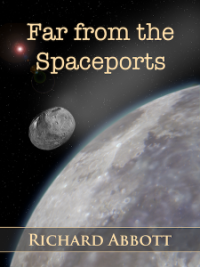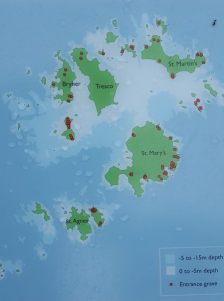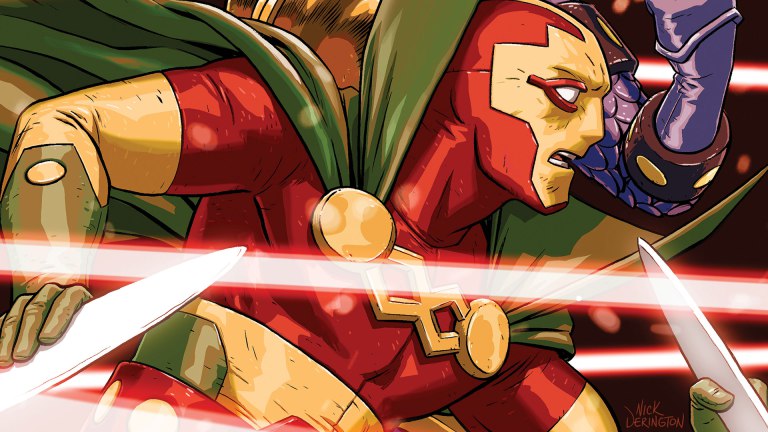 Click image for a review of Richard Abbott’s first foray into sci-fi
Click image for a review of Richard Abbott’s first foray into sci-fi
 Pockmarked Phobos, larger of two satellites orbiting Mars, by NASA/JPL-Caltech/ University of Arizona, via Wikimedia Commons
Pockmarked Phobos, larger of two satellites orbiting Mars, by NASA/JPL-Caltech/ University of Arizona, via Wikimedia Commons “I came away a satisfied customer, and decided that, apart from the constant changes in ambient light, and the eerie silence of the people walking around alleys and corridors, I quite liked Phobos. Slate was amused. ‘After a month you’d be craving noise. Here you don’t even let yourself sing in the shower. You’d never survive.’ She was probably right. As I walked, I found myself wondering how people managed their lives in situations where a certain amount of noise was called for. What happened during games? In the privacy of a shower? Or a bedroom? Slate was right; I had become quite obsessive about creeping about, and restraining my normal level of liveliness.”
As I started to write this, the European Space Agency was coming to terms with the loss of the Schiaparelli Mars lander. A breaking news item had just shown a picture captured by another satellite – NASA’s Mars Reconnaissance Orbiter – which probably shows its resting place. Schiaparelli was never supposed to last long on the surface, and the remaining component, the Trace Gas Orbiter, will continue to deliver good science for some time to come. But if I was in that team, I’d be disappointed. Since then, Elon Musk has announced what most people consider is a wildly ambitious plan to land settlers there in huge numbers.
 Kindle cover for Timing, the fantastic sequel to Far from the Spaceports (click image for audio excerpt)
Kindle cover for Timing, the fantastic sequel to Far from the Spaceports (click image for audio excerpt)
Mars has historically proven itself to be a difficult destination to land on, but in my novels I take for granted that the problem has been solved. So this post is not at all about how to land successfully on that planet, but about how I have imagined that society will adapt to new homes, whether on Mars or further afield.
In Far from the Spaceports, and its sequel Timing, the various scattered settlements are separated by days or weeks of travel time. Destinations on the outer rim of the solar system – which so far my characters have not visited – might take a few months. This puts them in the same degree of remoteness as European ports in the age of sail, or global ones in the age of steam. They are far enough apart that you pause to think about the commitment, and ensure you have plenty to do on the journey, but not so far that they take up a significant part of your lifetime.
“That close in, it wasn’t going to last long, in planetary terms. I probably had less than fifty million years to solve the case before the whole thing crumbled into a ring of dust and pebbles. No pressure, then.” Schiaparelli impact site Mars, NASA/JPL Caltech/University of Arizona (click image)
Schiaparelli impact site Mars, NASA/JPL Caltech/University of Arizona (click image)
Each of the places I describe has a particular character. The Scilly Isles – a group of asteroids somewhere in the gulf between Mars and Jupiter – were originally settled to extract minerals, but these are now largely exhausted. The residents are now trying to establish a new identity based on different enterprises. Some readers have commented that there’s a very British feel to them. In passing, the occupants of the real Scilly Isles off the Cornish coast have also needed to constantly adapt to the changing economic environment around them. They have not had much success on the mining front since the Bronze Age, but have successfully found new means of livelihood as older ones die out. Fishing, kelping, cut-flower production, and tourism have all taken turns, alongside the perennial use of the sea which borders them and shapes life there.
The economic life of a place – on Earth or elsewhere – depends crucially on its geography. We know that Phobos – a tiny moon orbiting very close in to Mars – is fragile. It has a rather low density, probably because much of its interior consists of loosely packed rubble rather than solid rock. It is, in all likelihood, riddled with faults. The ground is not sound and reliable. In Timing, this fact dominates life on Phobos, and the social customs are heavily skewed around this fact. Making loud or unnecessary noise is considered a taboo, backed up by local laws. Social gatherings have developed ways for people to be together quietly. Mining of any kind is out of the question, so the economy rests on other industries – like finance. The moon happens to be largely settled by (former) Canadians, and other places tend to have populations largely drawn from one or other of Earth’s nations.
 The (real) Scilly Isles
The (real) Scilly Isles
Mars, on the other hand, is huge in comparison to Phobos. Lots of authors have written speculatively about terraforming Mars – boosting the thin atmosphere in various ways with a view to restoring running water on the surface. In my version, this is a long way off, and each settlement is an enclosed pocket of habitable space within a harsh and inhospitable context. But the planet’s size means that there is room for all kinds of difference. There’s a college specialising in financial trading, a glider club – Mars is big on several kinds of extreme sports – and a large, chaotic arena for gambling and more exotic pleasures. And much more besides – if I ever take Mitnash and Slate back to Mars, there’s plenty of opportunity to explore other delights.
On a bigger scale, I see these settlements as basically independent and self-governing. Signal messages from Earth take between about four and twenty minutes to Mars, depending on relative positions. Out to the asteroid belt, that jumps up to somewhere between quarter and half an hour. That means up to an hour’s delay between asking a question and getting back the answer. You can’t have a real-time conversation like that – back in the days of the Apollo missions it was frustrating enough dealing with a three second round trip! And with journey times lasting weeks or months, you can’t easily enforce decisions either. So I’m not imagining any kind of solar system empire, or federation, or whatever.
 For a bit of fun, some code for an Alexa skill the author is developing. (Click image for more of the Alexa results: additional audio excerpt from Timing).
For a bit of fun, some code for an Alexa skill the author is developing. (Click image for more of the Alexa results: additional audio excerpt from Timing).
There is no unifying organisation deciding how things should be, and no system-wide constabulary to enforce them. Mitnash and Slate work for the Earth-based Economic Crime Review Board. In the course of their duties they might end up pretty much anywhere in the solar system, troubleshooting fraud and other financial crimes. But although they can ask for information from the main London office, they’re on their own day to day. They don’t, and can’t, go in with all guns blazing. Instead they resolve matters by more covert means, hacking into and fixing the computer systems which have been compromised. The battles they engage in are fought with lines of code, not brawn or physical weapons. Like those people today who consider themselves “ethical hackers”, their work takes them very close to the line between decent and dubious.
So, where next for Mitnash and Slate? There’s another plot brewing, tentatively called The Authentication Key, which will take them out to Saturn. There’s plenty of moons to choose from there, ranging from tiny fragments under a kilometre across right up to Titan, which is larger than the planet Mercury. And of course there are the rings….
 This NASA/JPL picture is a composite from the last few days of the recently-finished Cassini-Huygens mission, commenced on October 15, 2007 and named after seventeenth-century astronomers Giovanni Cassini and Christiaan Huygens. It presents a poignant image given its very recent ending (click for NASA’s farewell to Cassini).
This NASA/JPL picture is a composite from the last few days of the recently-finished Cassini-Huygens mission, commenced on October 15, 2007 and named after seventeenth-century astronomers Giovanni Cassini and Christiaan Huygens. It presents a poignant image given its very recent ending (click for NASA’s farewell to Cassini).
*********
About the author…
Richard Abbott writes fiction of several varieties, including both historical and speculative fiction. His historical is set in the Middle East at the end of the Bronze Age, around 1200 BC. It explores events in the Egyptian province of Canaan, following events in the life of a priest in the small hill town of Kephrath during a time of considerable change throughout the region.
His heretofore speculative writing is set in a near-future solar system exploring issues of high-tech crime and human-machine relationships.
 Far from the Spaceports introduces Mitnash Thakur and his virtual partner Slate as they investigate financial crime in the asteroid belt. Its sequel, Timing, was released in the second half of 2016.
Far from the Spaceports introduces Mitnash Thakur and his virtual partner Slate as they investigate financial crime in the asteroid belt. Its sequel, Timing, was released in the second half of 2016.
His latest publication, Half Sick of Shadows, a retelling and metamorphosis of Tennyson’s “The Lady of Shallot,” is now available for purchase, along with his other works, on Amazon and Amazon UK.
Richard lives in London, England and works professionally in IT quality assurance.
When not writing words or computer code, he enjoys spending time with family, walking, and wildlife, ideally combining all three pursuits in the English Lake District.
*********
You can follow and learn more about Richard Abbott and his books at Facebook and Google–and be sure to check out his brilliant collection of images! The author also has some amazing content at his blog, In a Milk and Honeyed Land, including Polly and Alexa, with space-related and not, his own reviews and reading list, information about his other books, and much more.
*********
Images courtesy Richard Abbott, except where otherwise indicated.
*********
Advertisements Share this:




